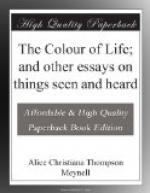Against this there was no modesty. Of all privacies, the last and the innermost—the privacy of death—was never allowed to put obstacles in the way of public action for a public cause. Women might be, and were, duly suppressed when, by the mouth of Olympe de Gouges, they claimed a “right to concur in the choice of representatives for the formation of the laws”; but in her person, too, they were liberally allowed to bear political responsibility to the Republic. Olympe de Gouges was guillotined. Robespierre thus made her public and complete amends.
A POINT OF BIOGRAPHY
There is hardly a writer now—of the third class probably not one—who has not something sharp and sad to say about the cruelty of Nature; not one who is able to attempt May in the woods without a modern reference to the manifold death and destruction with which the air, the branches, the mosses are said to be full.
But no one has paused in the course of these phrases to take notice of the curious and conspicuous fact of the suppression of death and of the dead throughout this landscape of manifest life. Where are they—all the dying, all the dead, of the populous woods? Where do they hide their little last hours, where are they buried? Where is the violence concealed? Under what gay custom and decent habit? You may see, it is true, an earth-worm in a robin’s beak, and may hear a thrush breaking a snail’s shell; but these little things are, as it were, passed by with a kind of twinkle for apology, as by a well-bred man who does openly some little solecism which is too slight for direct mention, and which a meaner man might hide or avoid. Unless you are very modern indeed, you twinkle back at the bird.
But otherwise there is nothing visible of the havoc and the prey and plunder. It is certain that much of the visible life passes violently into other forms, flashes without pause into another flame; but not all. Amid all the killing there must be much dying. There are, for instance, few birds of prey left in our more accessible counties now, and many thousands of birds must die uncaught by a hawk and unpierced. But if their killing is done so modestly, so then is their dying also. Short lives have all these wild things, but there are innumerable flocks of them always alive; they must die, then, in innumerable flocks. And yet they keep the millions of the dead out of sight.
Now and then, indeed, they may be betrayed. It happened in a cold winter. The late frosts were so sudden, and the famine was so complete, that the birds were taken unawares. The sky and the earth conspired that February to make known all the secrets; everything was published. Death was manifest. Editors, when a great man dies, are not more resolute than was the frost of ’95.
The birds were obliged to die in public. They were surprised and forced to do thus. They became like Shelley in the monument which the art and imagination of England combined to raise to his memory at Oxford.




